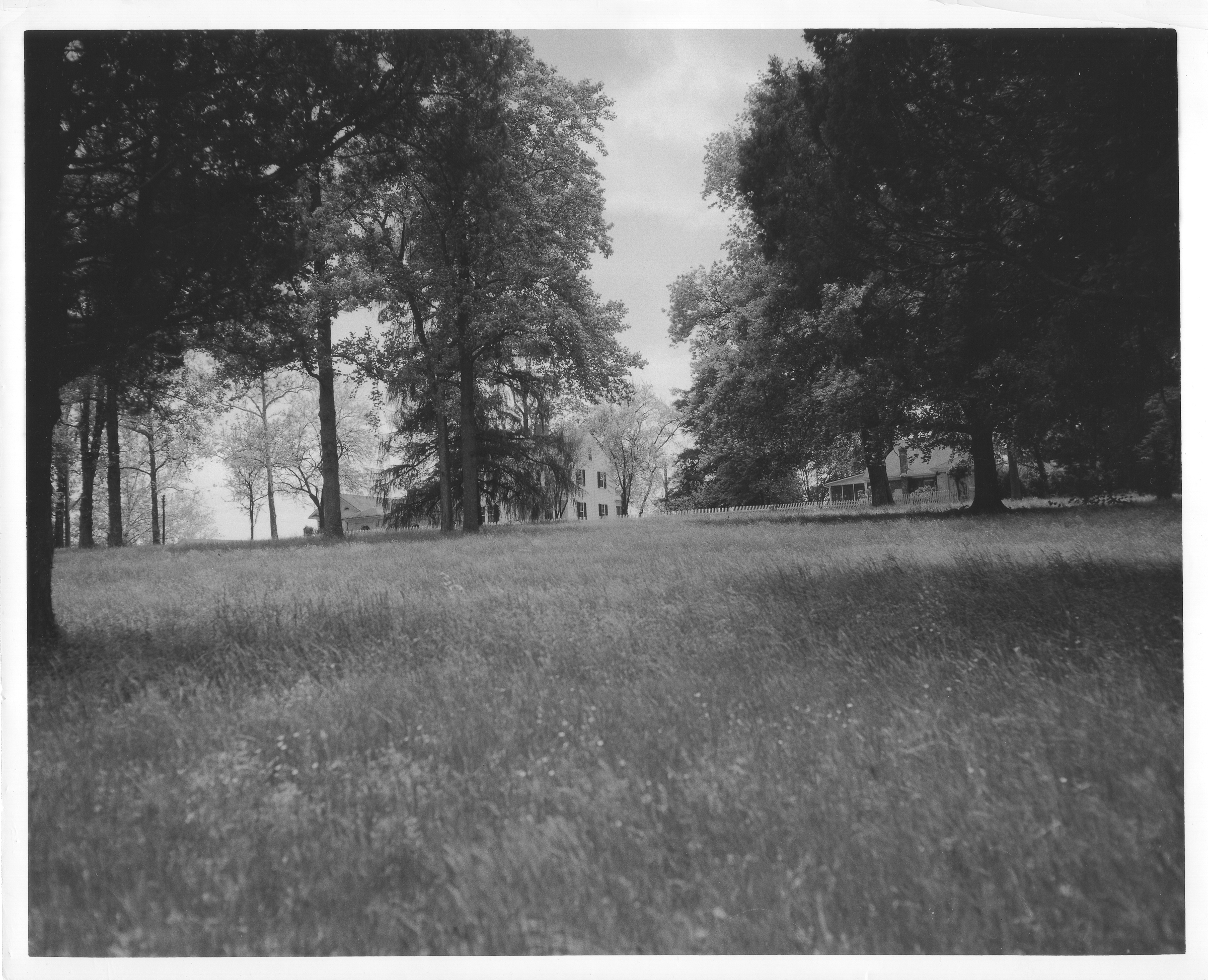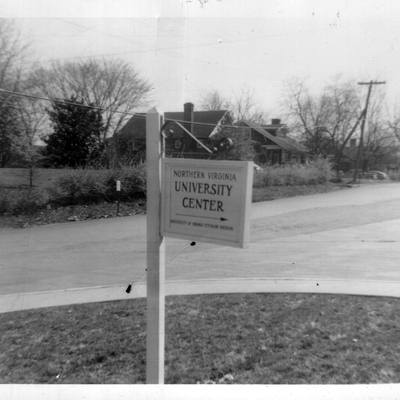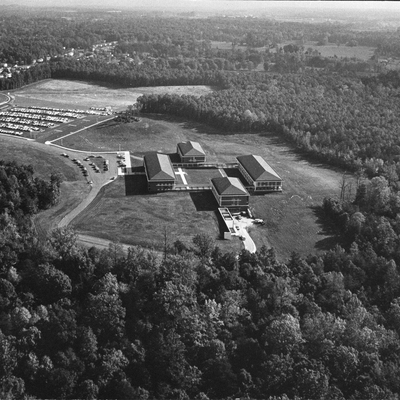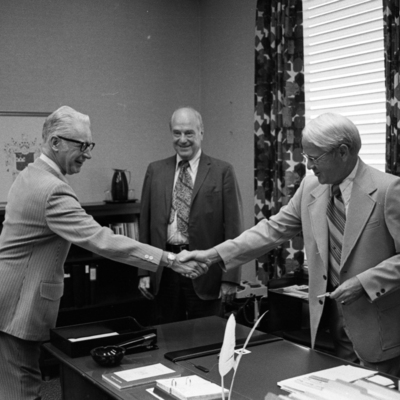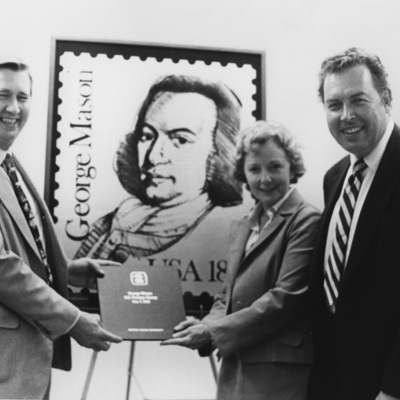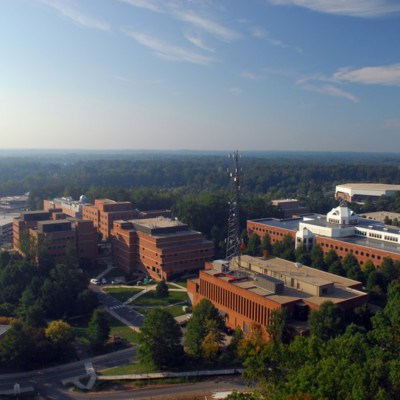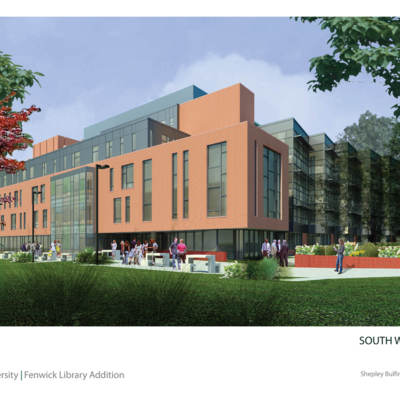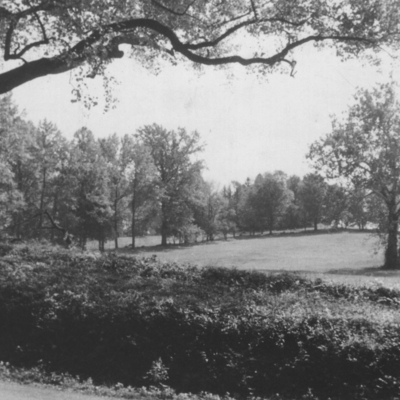Ravensworth vs. Sunset Hills
Over the course of the search many sites were mulled over--as many as two-dozen. But, from the many properties studied, only two were seriously considered for the new home of the Northern Virginia branch of the University of Virginia. These were the Ravensworth Farm and Sunset Hills tracts. These two sites were on opposite ends of Fairfax County and were separated by about ten miles. In the end, each of the two groups, the Board of Visitors of the University of Virginia, and the Advisory Council, settled on its own site, arguing that it best fit the guidelines established by the University.
At the intersection of Braddock Road (Virginia Rt.620) and the future Capital Beltway, the former Ravensworth Farm would be served by decent roads, and its location would put it just south of the geographic and population centers of the Northern Virginia region in 1956. The land was once owned by Col. William Fitzhugh the grandfather of Mary Custis Lee, and now was owned by Edward M. Carr, James McIlvaine, and John C. Mowbray. The fact that the site had local history implications was seen as an asset by its backers. In the spring of 1956 the owners of Ravensworth initially offered fifty acres as a donation with an option to buy up to an additional 240 acres. They also offered conveyance of existing buildings and other cash incentives as well. [1] Combined, these factors made Ravensworth quite attractive to the Advisory Council. [2] The only perceptible drawback to the Ravensworth site was the fact that the federal government had proposed the construction of an international airport four miles southeast at Burke in the early 1950s. There was concern that if the future flight path went from east to west, the Ravensworth site would be directly in the path of jet planes during takeoff and final approach for landing. It was suggested by some that the noise could be detrimental to the everyday operations of the campus. [3]
Sunset Hills, on the other hand, was located in Herndon in the northwestern part of the county. Located on the north side of Route 606 near what is now Reston, it belonged to the sons of the late A. Smith Bowman, founder of the A. Smith Bowman Distillery, and maker of Virginia Gentleman bourbons. The site was more than twenty miles away from Alexandria, Arlington, and Falls Church, sparsely populated, served by a network of smaller roads fed by Route 7 to the North, and lacked a convenient water and sewerage source. The Bowman brothers initially offered 50 acres of land along with $25,000 cash with which to erect the first buildings back in December 1954 to President Darden. [4]In March 1956 the offer was expanded to 250 acres, with an option to purchase 250 additional acres. [5]
On June 7, 1956 the Advisory Council met to consider the Ravensworth tract. In a vote among its members, Ravensworth was accepted unanimously. [6] Though the Bowman offer was studied by the Council, it wasn’t given much consideration, primarily because of its location. To the Council, Sunset Hills was too far west from where the majority of the potential students lived. For all intents and purposes it seemed as if the search for a permanent home for the new college was over. The location was right; the size fit; the cost was reasonable; and, located between the more populous Alexandria, Arlington, and Falls Church on the east and less populous Herndon, Chantilly, and Centreville on the west, it could be argued that it was nearly in the exact center of the Northern Virginia population. All that was needed was consideration and approval by the Board of Visitors.
At its September 15, 1956 meeting, the Board assembled to consider the sites currently available to the University. In this meeting, a special Board subcommittee submitted its preliminary recommendation of the Sunset Hills tract for the construction of the new campus. Cited among reasons for its selection were the ample acreage, the projection that the Herndon area was going to be near the center of the area’s population in the future as land development increased in the western end of the county, and numerous recommendations from interested persons in western Fairfax and Loudoun Counties. The proximity of the proposed airport and potential noise was the Board’s sole objection to Ravensworth. [7] It was, at that time, considered common knowledge among many in Northern Virginia that if an airport was going to be built at Burke, the flight path would travel north to south so as not to interfere with traffic using the existing Washington National Airport located north of Alexandria to the east. [8]C. Harrison Mann, Jr. adds in a footnote to his unpublished manuscript that the Burke site was never seriously considered for the international airport. [9] Ironically, in 1958 the federal government abandoned the Burke location for a larger tract in Chantilly, situating it very near the Sunset Hills site. This facility, now known as Washington Dulles International Airport, opened in 1962.
As expected, the Advisory Council and the local jurisdictions did not care about this decision. Mann’s letter of October 18 to the Board of Visitors fully registered their dissent. [10] This location was impractical and utterly unacceptable. By the end of 1956, the question of who had the right to choose the location for the new college was in question. Advisory Council chairman, Clarence Steele, and others suggested that if the Council, who represented the jurisdictions that were going to pay for the land, could not choose where the branch would be built, then perhaps the Council should disband. [11]
At about this same time the Board of Control for the Establishment of a Branch College in Northern Virginia stepped into the picture. The Board of Control was created by the General Assembly soon after the 1956 passage of Resolution 5, enabling the University to create a branch in northern Virginia. The Board of Control would take up the site selection duties of the Advisory Council, if necessary, and at the end of 1956, it became so. Fortunately, many of the people involved in the Advisory Council were also members of the Board of Control. [12] The Board of Control would use a different approach than that of the Advisory Council to find land. Instead of seeking land offerings through word of mouth or through personal connections, it publically requested proposals of land offerings. In early 1957 the Board of Control received information on new sites as well as upgraded offers on previously-studied sites. Although many new and upgraded parcels were offered and examined, Ravensworth and Sunset Hills remained the frontrunners. [13] The Sunset Hills owner’s new offer included a donation of 250 acres, an additional 250 for sale for $1000 per acre, and $25,000 cash. As expected, the Board of Visitors continued its strong endorsement of Sunset Hills.
However, the newly established Board of Control, which represented the local governments participating in the creation of the Northern Virginia branch, did not wish to have anything to do with a site so far away from the center of the population. Board chairman C. Harrison Mann, Jr. argued vehemently against the BOV’s recommendation of Sunset Hills and implored them to reconsider. While some members of the Council seriously considered accepting the Board’s recommendation, representatives from Alexandria, the jurisdiction furthest away, stated that they would not support the Sunset Hills location and would “withdraw from any participation in the establishment of the college.” [14] The city's motivation was clear: the Sunset Hills tract was too far from the City of Alexandria to make a commuter college practical. If its taxpayers’ money was going to help build this college, Alexandria wanted them to have reasonable access to it. None of the other groups on the Board of Control wished to see Alexandria leave. They hoped to keep a common front and work together. Also, if Alexandria pulled out, the financial burden would increase for each of the remaining members once a site was finally chosen.
When it was all but certain that the Ravensworth would never be approved by the Board of Visitors, the Board of Control began looking at other pieces of land and fell upon the Chiles tract three miles north of Ravensworth. The Chiles tract was seen by many as the next best location to Ravensworth because it was located in the exact center of the population of all four jurisdictions. [15] This site also was located right next to the future Fairfax Hospital, and the “Board [of Control] saw in this close proximity an ideal situation for a School of Nursing.” [16] Although this tract was not for sale at the time, it was suggested that the Fairfax County government could have used eminent domain to acquire the land. This made the debate of the Chiles tract a moot point because President Darden made it clear that the University was not interested in acquiring land by condemning it. [17] The Chiles tract was thought to be valued at about $623,000, a sum that was a bit outside of the budget for the group represented by the Board of Control.
In January of 1958, President Darden wrote to Mann, asking him to consider the Sunset Hills tract and try to convince others on the Board of Control to see it as an opportunity to establish a college in Northern Virginia. “Certainly it would seem to be wiser to have it there rather than abandon it.” [18] In the Washington Evening Star on April 3rd Darden was quoted as saying, “I would regret to see the University leave Northern Virginia, but I am satisfied we cannot carry on unless we have general support in the area. If these very deep differences cannot be resolved I would, with real sadness, recommend that we withdraw.” [19] In his manuscript, Mann infers that Darden was losing patience with the process and threatened to delay or abandon the project altogether unless the Board of Control go along with the Board of Visitors and approve the Sunset Hills site. Both the Board of Visitors, and the University, appeared dead-set on the Sunset Hills site, and did not seem to be considering any others by this time. This was evident in the shift in attitude towards the proposed airport now slated for Chantilly. As Mann notes in his history, “Even the proximity of the airport at Dulles was advanced as an argument for Sunset Hills, though Judge Bryan (Judge Albert V. Bryan, a member of the Board of Visitors) had used the airport argument so effectively against Ravensworth when it was believed that it might be located at Burke.” [20]
With the final vote of the Board of Visitors on the permanent site for the college set for February 1, Northern Virginians initiated some last-minute scrambling in a final attempt to secure a more convenient location for the branch. On Sunday, January 19, 1958, Fairfax Mayor John C. Wood called an emergency Town Council meeting to discuss the possibility of the Town of Fairfax becoming a player in this process. Wood represented the owners of the Ravensworth property, and he had first-hand knowledge of the difficulties surrounding the site selection for the branch. Most probably by that time, Wood was certain that Ravensworth would never be selected. He was aware of a tract of land owned by a Fairfax lawyer and former Commonwealth’s Attorney located just south of the Town of Fairfax and suggested to the Council that the Town purchase the land in an effort to lure the University to Fairfax. The Town Council unanimously agreed to secure an option on the land and offer it to the University as a donation. Hopefully, the University would accept, bringing the branch college to Fairfax. He submitted the proposal to C. Harrison Mann on January 21 for the Board of Control’s consideration. [21] The Board of Control at that time was still hoping that the Board of Visitors would somehow reconsider its bias against Ravensworth.
The owners of Ravensworth issued one more offer, which increased the amount of donated land in order to make the offer more competitive with the Sunset Hills site. The Board of Control voted on this offer, and all but one member voted in favor of the Ravensworth site. The Board of Control sent their recommendations to the Board of Visitors in Charlottesville a few days before their vote.
Mann himself traveled to Charlottesville for the February 1 meeting to make sure that he was on hand to answer any questions the Board of Visitors might have during their deliberations. The Board did not call upon Mann during the meeting, and Mann received a phone call at his Charlottesville hotel notifying him that the Board of Visitors had voted 9 to 2 in favor of the Sunset Hills site. [22] This effectively ended the competition between Ravensworth and Sunset Hills.
Browse items related to the Ravensworth site.
Browse items related to the Sunset Hills site.
Browse items related to the site selection.

